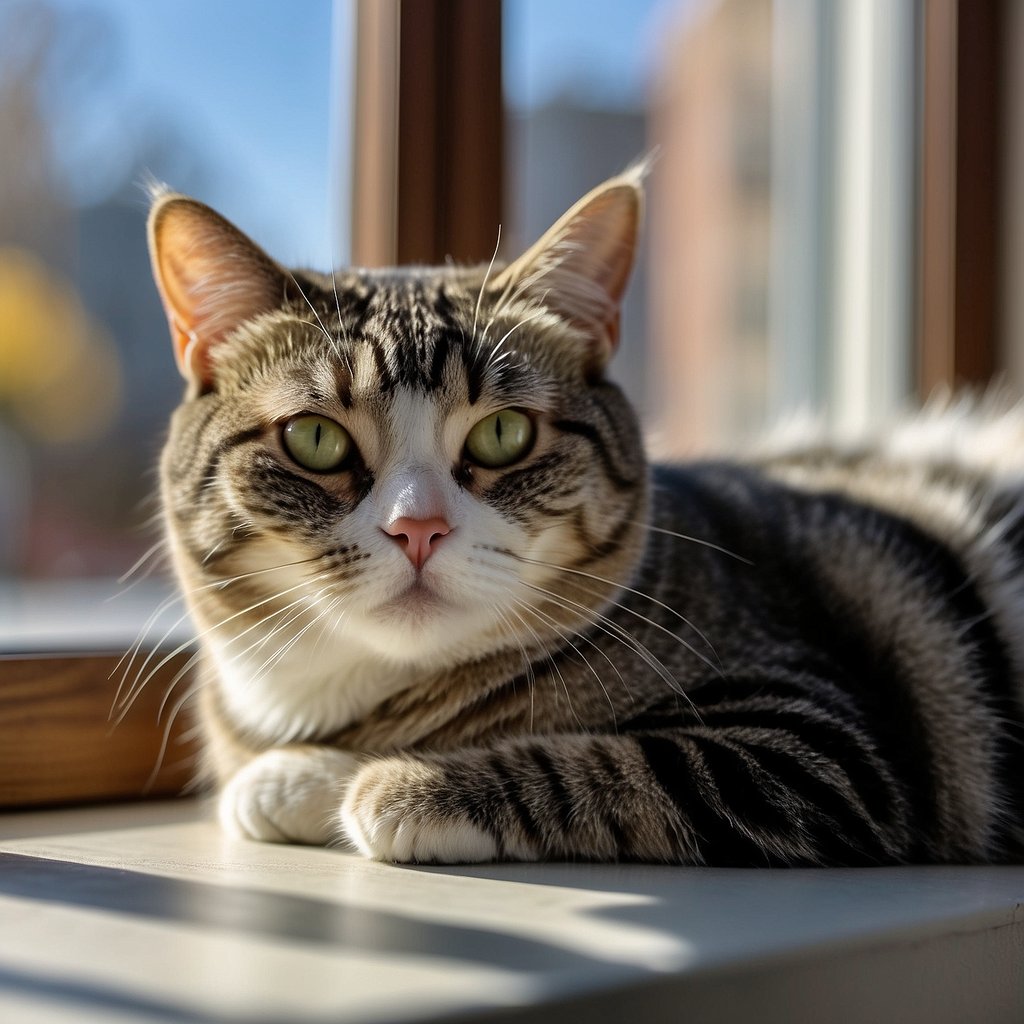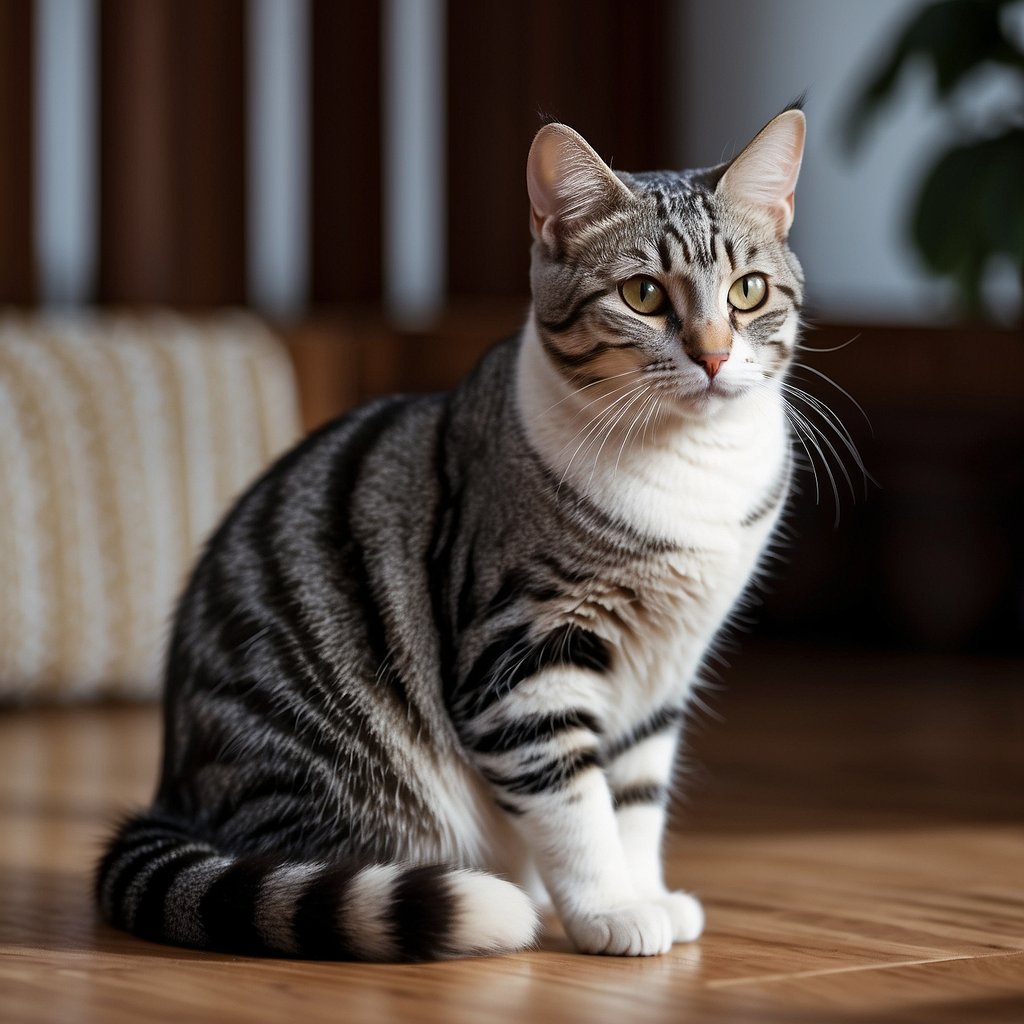
American Shorthair Cat: Breed Traits and Care Guide
The American Shorthair cat is a breed with a rich heritage and a reputation for being a low-maintenance and affectionate companion. With its origins traceable to the early European settlers’ cats that arrived in North America, this breed has been a cherished part of many households. The American Shorthair is known for its robust health, good looks, and friendly disposition. This breed exhibits a variety of colors and patterns and is characterized by its round face and thick, dense coat.
One of the most appealing traits of the American Shorthair is its adaptability to various living environments, making it suitable for both houses and apartments. These cats possess a gentle and playful nature that makes them excellent family pets, compatible with children and other animals. They are also known for being intelligent and can be trained to follow simple commands and use a scratching post. Their even-tempered personality and moderate activity level mean they fit well into the family dynamic.
Key Takeaways
- The American Shorthair is an adaptable and affectionate breed with a strong and healthy lineage.
- They are well-suited to a variety of living situations and make great family pets.
- The breed is known for its intelligence and can be easily trained for basic commands and good behavior.

Breed Overview
The American Shorthair cat is a breed with a rich heritage and a wide array of physical and behavioral characteristics. It is known for its muscular build, pleasant demeanor, and adaptability to family life.
Breed History
The American Shorthair traces its roots to European cats, predominantly British Shorthairs, brought to North America by early settlers. These cats were highly valued for their skill in protecting cargo from rodents during voyages. In the United States, through selective breeding, they developed into the distinct American Shorthair breed.
Breed Profile
Recognized by The International Cat Association (TICA) and other cat fancier organizations, the American Shorthair is appreciated for its balance, strength, and endurance. The breed standard seeks a well-built cat that fits a working cat’s profile.
Physical Characteristics
Size: Adults typically weigh between 8-15 pounds, with males generally being larger than females.
Body: The American Shorthair has a muscular, strong body, with medium to large size, indicating its powerful hunting capabilities.
Head: The breed sports a large, round head with medium-sized ears.
Coat: The coat is dense and comes in a variety of colors and patterns, including silver, red, blue, black, brown, tortoiseshell, cream, and cameo.
Tail: It has a thick, well-furnished tail.
Behavioral Traits
The American Shorthair exhibits an active, personable, and friendly personality, making them an excellent companion. They possess a playful spirit and intelligence that contributes to their independent nature and moderate vocality.
Health and Lifespan
American Shorthairs are generally healthy, with an average lifespan ranging from 15 to 20 years. Common health issues that may affect them include hypertrophic cardiomyopathy, obesity, and feline lower urinary tract disease. Many health problems are hereditary, thus careful breeding practices are important.
Care and Maintenance
Grooming: They possess a coat that requires minimal grooming.
Exercise: Regular exercise is essential for preventing obesity.
Feeding: A balanced diet tailored to their nutritional needs aids in healthy weight management.
Shedding: Regular brushing can help manage shedding.

Living with an American Shorthair
American Shorthairs are known for their adaptable nature and even-tempered personality, making them an ideal pet for various households. They blend well with families, show compatibility with other pets, and possess a playful yet not overly demanding activity level.
Compatibility with Families
American Shorthairs are a kid-friendly breed, showing patience and gentleness around children. Their muscular bodies and resilient nature make them a good companion for active kids. Families will find these cats to be affectionate without being overbearing, allowing for cohabitation that is harmonious for all.
Activity Needs
Although not as high-energy as some other breeds, American Shorthairs have an active and playful side. They enjoy interactive toys and games that cater to their hunting instincts. Daily playtime is essential to keep them stimulated, but their exercise needs are moderate, making them suitable for less active owners too.
Adaptability
American Shorthairs are notably adaptable and easygoing, which makes them perfect for both apartments and houses. Their history as working cats has lent them a high degree of endurance, and they can thrive in various living conditions as long as they are provided with the basics of good care and company.
Bonding and Affection
Known for their moderate affection level, American Shorthairs form strong bonds with their owners without demanding constant attention. Their independence means they can entertain themselves, but they also appreciate quality time with their human companions. While not typically lap cats, they show their affection through their presence and companionable interactions.

Training and Intelligence
The American Shorthair cat is known for its receptive nature to training and notable intelligence, making it a suitable pet for engaging in various learning activities and obedience exercises.
Trainability
American Shorthair cats exhibit a high level of trainability due to their ability to understand and respond to human direction. Training these cats typically involves:
- Consistency: Employing regular training sessions.
- Positive Reinforcement: Using treats and praises to encourage desired behaviors.
- Patience: Understanding that each cat learns at its own pace.
These cats often excel in learning household rules and can be trained to perform simple tasks such as using a scratching post or litter box. As working cats, they also possess natural hunting instincts that can be shaped through training exercises.
Intelligence
With a natural propensity for problem-solving and curiosity, American Shorthair cats display a level of intelligence that enhances their learning abilities. Their mental capabilities can be seen in behaviors such as:
- Curiosity: Investigating new objects and environments.
- Problem-solving: Finding solutions to challenges such as accessing out-of-reach areas.
This breed has a history as working cats, which contributes to their independent nature and intelligence, allowing them to adapt to various environments and tasks with ease. Their ability to learn and remember commands makes them relatively obedient, and many American Shorthairs can master basic commands and tricks with proper guidance.

Breeding and Genetics
The American Shorthair, with its diverse heritage, stems from a combination of careful selective breeding programs and natural selection. This balance has resulted in the breed’s distinct appearance and varying health predispositions.
Selective Breeding
The breeding program of the American Shorthair has focused on enhancing specific physical traits to conform to a recognized standard. Selective breeding has ensured the development of the breed’s well-known robust and muscular build, with particular emphasis on maintaining a strong jaw, a characteristic coat pattern, and coloration. Breeders have employed genetic screening to sustain the breed’s standards, reduce chances of hereditary issues, and uphold good health.
Genetic Health Issues
The genetics of the American Shorthair also carry implications for the breed’s health. Unfortunately, this cat is known to be at a predisposed risk for hereditary conditions such as Hypertrophic Cardiomyopathy (HCM), which is the most common form of heart disease in cats. Responsible breeding programs incorporate genetic testing for HCM and other health concerns to strive for healthier future generations. They work to identify carriers and modify breeding practices to mitigate the spread of such conditions, thus prioritizing the long-term health of the breed.
Common Comparisons
When considering the American Shorthair cat, it is often compared to other breeds based on their physical and behavioral characteristics. These comparisons can help prospective cat owners decide which breed might be the best fit for their home.
Versus Other Breeds
American Shorthairs are known for their hardy constitution and playful yet calm demeanor, setting them apart from other breeds. They are medium to large in size with a muscular build, a broad chest, and a round face with short ears. Compared to more slender, active breeds like the Siamese, the American Shorthair is more laid-back and less vocal, yet still enjoys engaging in lively play sessions.
Table of Characteristics:
| Breed | Size | Build | Temperament |
|---|---|---|---|
| American Shorthair | Medium to Large | Muscular | Playful, calm |
| Siamese | Medium | Slender | Active, vocal |
American Shorthair versus Domestic Shorthair
The term “Domestic Shorthair” is often used to describe any shorthaired cat that does not have a pedigree or belong to a recognized breed. In contrast, the American Shorthair is a pedigreed breed with consistent traits. Domestic Shorthairs exhibit a wide range of characteristics because they come from a mixed ancestry.
- Traits Comparison:
- American Shorthair: Predictable physical traits, recognized by cat fancier associations.
- Domestic Shorthair: Varied appearance, no breed standard.
American Shorthair versus Exotic Shorthair
The Exotic Shorthair was originally bred as a shorthaired version of the Persian, blending the Persian’s features with the easy-care coat of the American Shorthair. Both the American Shorthair and the Exotic Shorthair are medium to large, but the Exotic has the Persian’s flat face, compared to the American’s round face.
Key Differences:
- Facial Structure: The Exotic Shorthair has a flat face, while the American Shorthair has a fuller, round face.
- Coat: While both have short hair, the Exotic’s coat is plush and dense like a Persian’s.
By understanding these comparisons, one can appreciate the unique qualities that define the American Shorthair and how they distinguish themselves among different breeds and classifications of cats.
Frequently Asked Questions
This section answers common inquiries about the American Shorthair cat, a breed known for its distinct characteristics and history.
How can you distinguish an American Shorthair cat from other domestic shorthair cats?
The American Shorthair cat typically has a well-built, muscular body, a full-cheeked face, and a distinctively dense and short coat. These features set it apart from other domestic shorthair cats, which may have a more varied physique and undefined lineage.
What is the typical temperament and sociability of an American Shorthair cat?
They are known for their gentle and easygoing nature. This breed generally enjoys the company of humans and other pets, making them excellent family companions.
What are the common characteristics of an American Shorthair cat’s coat and color patterns?
The coat is short and thick, with a texture that can withstand various climates. These cats come in more than 80 color combinations and seven patterns, with the silver tabby being notably common.
How much does an adult American Shorthair cat usually weigh?
An adult American Shorthair cat usually weighs between 7 to 12 pounds, with males being typically larger than females.
What are the origins and historical purposes of the American Shorthair breed?
The breed originated from cats brought to America by early European settlers. Initially prized for their hunting skills to protect food supplies from rodents, these cats have now become a well-loved domestic breed.
What should be considered when looking to adopt an American Shorthair cat?
Prospective owners should consider the cat’s need for daily interaction and exercise. It is important to ensure that they can provide a loving environment and meet the breed’s nutritional and healthcare needs.